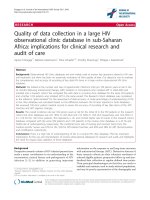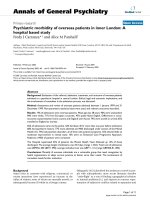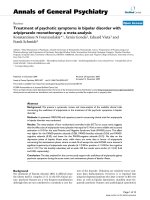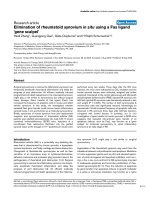Báo cáo y học: "Standardisation of data collection in traumatic brain injury: key to the future" pot
Bạn đang xem bản rút gọn của tài liệu. Xem và tải ngay bản đầy đủ của tài liệu tại đây (40.86 KB, 2 trang )
Available online />Page 1 of 2
(page number not for citation purposes)
Abstract
Great variability exists in data collection and coding of variables in
studies on traumatic brain injury (TBI). This confounds comparison
of results and analysis of data across studies. The difficulties in
performing a meta-analysis of individual patient data were recently
illustrated in the IMPACT project (International Mission on
Prognosis and Clinical Trial Design in TBI): merging data from 11
studies involved over 10 person years of work. However, these
studies did confirm the great potential for advancing the field by
this approach. Although randomized controlled trials remain the
prime approach for investigating treatment effects, these can never
address the many uncertainties concerning multiple treatment
modalities in TBI. Pooling data from different studies may provide
the best possible source of evidence we can get in a cost efficient
way. Standardisation of data collection and coding is essential to
this purpose. Recommendations hereto have been proposed by an
interagency initiative in the US. These proposals deserve to be
taken forward at an international level. This initiative may well
constitute one of the most important steps forwards, paving the
road for harvesting successful results in the near future.
Traumatic brain injury (TBI) is a field in medicine with one of
the greatest unmet needs [1]. Severe injuries constitute a
leading cause of death and disability worldwide, with
devastating effects on patients and their relatives and high
socioeconomic costs. TBI is a heterogeneous disease in
terms of cause, pathology, severity and prognosis. Procedures
for data collection and coding of variables in TBI studies are
equally heterogeneous. This was recently illustrated in the
IMPACT project (International Mission on Prognosis and
Clinical Trial Design in TBI) in which individual patient data
from three observational series and eight clinical trials were
merged into a large registry, forming a culture medium for
exploring concepts to improve the design of clinical trials in
TBI [2]. Creating this registry involved over 10 person years
of work due to the widely differing structure of the study
datasets, poor documentation and variability in coding. Lack
of standardization has been a major factor confounding
comparisons between studies, and complicating meta-
analyses of individual patient data.
Analysing individual patient data across studies may well be
key to advancing the clinical field of TBI, and improving treat-
ment. Much uncertainty exists regarding the benefit and risk
of many treatment modalities in TBI. This uncertainty is
reflected in the paucity of class I and II evidence underpinning
authoritative guideline recommendations [3]. Although rando-
mized controlled trials remain the prime approach for investiga-
ting treatment effects, these are costly and logistically
demanding. Consequently, it seems unlikely that we can mount
adequately powered trials to study all relevant treatment
modalities. Pooling data from multiple studies can provide an
alternative source of evidence that can be realistically obtained
in a cost-efficient way. Relating differences in trauma organiza-
tion and treatment approaches to outcome will permit both
better targeting of prevention and exploration of reasons for
observed differences. Further, this approach provides a
means of generating and refining hypotheses, and ranking
them in importance for testing.
The great potential of performing a meta-analysis of individual
patient data was demonstrated by the IMPACT studies.
Simulation studies showed that the statistical power in TBI
trials may be increased up to 50% by utilizing more efficient
approaches to the analysis [4]. Extensive prognostic analysis
defined the strength of many known predictors more
precisely, yielded new predictors and has resulted in
validated prognostic models for use in moderate and severe
TBI [5]. The benefit of analyzing large numbers of patients
was also demonstrated in the development of prognostic
models based on the CRASH trial [6]. These models are
useful for providing information on expectations of outcome,
for classifying the severity of brain injury, for stratification and
covariate adjustment in clinical trials, and as reference for
evaluating quality of care.
Commentary
Standardisation of data collection in traumatic brain injury:
key to the future?
Andrew IR Maas
Department of Neurosurgery, University Hospital Antwerp, Wilrijkstraat 10, 2650 Edegem, Belgium
Corresponding author: Andrew IR Maas,
Published: 16 December 2009 Critical Care 2009, 13:1016 (doi:10.1186/cc8163)
This article is online at />© 2009 BioMed Central Ltd
TBI = traumatic brain injury.
Critical Care Vol 13 No 6 Maas
Page 2 of 2
(page number not for citation purposes)
Standardization of data collection and coding is essential to
facilitate sharing of results and to analyze data across
studies.
Initial steps undertaken by the IMPACT study group towards
development of standardization were integrated in the US
into a much larger interagency initiative towards ‘an integra-
ted approach to research in psychological health and
traumatic brain injury’. This initiative included working groups
on demographics and clinical assessment, biomarkers,
neuroimaging and outcome. The global aim was to develop
recommendations on selection and coding of data elements
for studies across the broad spectrum of TBI.
The process was consensus driven, with multidisciplinary
input from a broad range of experts, covering the entire
trauma chain from emergency medicine to rehabilitation and
late outpatient care. Recommendations were formulated and
templates produced summarizing coding formats, motivation
of choices and procedures. The data elements are contained
in modules, which are grouped in categories. For example,
the data elements ‘age, gender and race’ are contained in the
module ‘demographics’ under the category ‘subject charac-
teristics’. As the required level of detail may vary greatly with
the aim of a specific study, three versions for coding data
elements were developed: a basic, an advanced, and an
extended format with the greatest level of detail in the
extended version. The coding of these versions is such that
more detailed coding can be collapsed into the basic version,
thus facilitating comparison across studies. The draft
recommendations and templates are available from the author
and will be posted on the web in early 2010 [7].
This work presents a major advance towards standardisation,
but has not yet addressed approaches to analysis of para-
meters such as intracranial pressure that are continuously
monitored in the ICU setting. Here, approaches are often
crude and widely diverging, using only momentary or
summary measures. Few studies have taken advantage of the
more extensive information contained in continuous monitor-
ing. We strongly advocate further development of software
aimed at capturing the frequency distribution of measured
values during continuous monitoring and further research into
the best approaches to analysis.
These developments may well constitute one of the most
important steps forward in the field of clinical trials in TBI,
paving the road for harvesting successful results in the near
future.
Competing interests
Grant support was provided by NIH-NINDS (NS 042691)
and further funded as part of the interagency initiative in the
US towards ‘an integrated approach to research in
Psychological Health and Traumatic Brain Injury’.
Acknowledgements
This commentary is based upon extensive collaborative work, per-
formed by the IMPACT study group and the interagency working group
on Demographics and Clinical Assessment. Grant support was pro-
vided by NIH-NINDS (NS 042691) and further funded as part of the
interagency initiative in the US towards ‘an integrated approach to
research in Psychological Health and Traumatic Brain Injury’.
References
1. Maas AIR, Stocchetti N, Bullock R: Moderate and severe trau-
matic brain injury in adults. Lancet Neurol 2008, 7:728-741.
2. Maas AI, Marmarou A, Murray GD, Teasdale SG, Steyerberg EW:
Prognosis and clinical trial design in traumatic brain injury:
the IMPACT study. J Neurotrauma 2007, 24:232-238.
3. Brain Trauma Foundation [ />PageServer]
4. Maas AI, Steyerberg EW, Marmarou A, McHugh GS, Lingsma HF,
Butcher I, Lu J, Weir J, Roozenbeek B, Murray GD: IMPACT rec-
ommendations for improving the design and analysis of clini-
cal trials in moderate to severe traumatic brain injury.
Neurotherapeutics, in press.
5. Steyerberg EW, Mushkudiani N, Perel P, Butcher I, Lu J, McHugh
GS, Murray GD, Marmarou A, Roberts I, Habbema JD, Maas AI:
Predicting outcome after traumatic brain injury: development
and international validation of prognostic scores based on
admission characteristics. PLoS Med 2008, 5:e165.
6. MRC CRASH Trial Collaborators, Perel P, Arango M, Clayton T,
Edwards P, Komolafe E, Poccock S, Roberts I, Shakur H, Steyer-
berg E, Yutthakasemsunt S: Predicting outcome after traumatic
brain injury: practical prognostic models based on large
cohort of international patients. BMJ 2008, 336:425-429.
7. [www.nindscommondataelements.org]









